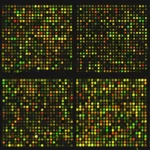
Single-Cell Omics: Unraveling Cellular Heterogeneity with Unprecedented Resolution
February 21, 2025Single-cell omics represents a transformative approach in biological research, enabling scientists to study individual cells within complex tissues and organisms. This technology has revolutionized our understanding of cellular heterogeneity, providing insights into the diversity of cell types, states, and functions that were previously obscured in bulk tissue analyses. Advances in single-cell sequencing technologies have been particularly impactful in fields such as cancer research, immunology, and developmental biology, leading to groundbreaking discoveries and new therapeutic avenues.
The Evolution of Single-Cell Omics
Traditional bulk sequencing methods analyze the average gene expression or molecular profiles of thousands or millions of cells simultaneously. While useful, these approaches mask the unique characteristics of individual cells, limiting our ability to understand cellular diversity and rare cell populations. Single-cell omics overcomes this limitation by isolating and analyzing individual cells, providing a high-resolution view of cellular heterogeneity.
The development of single-cell sequencing technologies began with single-cell RNA sequencing (scRNA-seq) in the early 2010s. Since then, the field has expanded to include single-cell genomics, epigenomics, proteomics, and multi-omics approaches, which integrate multiple layers of molecular data from the same cell. These advancements have been driven by innovations in microfluidics, barcoding, and computational tools for data analysis.
Key Technologies in Single-Cell Sequencing
- Single-Cell RNA Sequencing (scRNA-seq):
- scRNA-seq measures gene expression at the single-cell level, enabling the identification of distinct cell types and states within a tissue.
- Technologies like 10x Genomics, Drop-seq, and Smart-seq2 have made scRNA-seq more accessible and scalable.
- Applications include mapping cell lineages, identifying rare cell populations, and studying dynamic gene expression changes.
- Single-Cell DNA Sequencing:
- This approach analyzes genomic variations, such as mutations and copy number alterations, in individual cells.
- It is particularly valuable in cancer research, where tumor heterogeneity plays a critical role in disease progression and treatment resistance.
- Single-Cell Epigenomics:
- Techniques like single-cell ATAC-seq (Assay for Transposase-Accessible Chromatin) and ChIP-seq (Chromatin Immunoprecipitation Sequencing) reveal chromatin accessibility and epigenetic modifications at single-cell resolution.
- These methods provide insights into gene regulatory mechanisms and cell identity.
- Single-Cell Proteomics:
- Mass cytometry (CyTOF) and single-cell western blotting enable the quantification of proteins and post-translational modifications in individual cells.
- This is crucial for understanding signaling pathways and cellular responses to stimuli.
- Multi-Omics Integration:
- Emerging technologies like CITE-seq (Cellular Indexing of Transcriptomes and Epitopes by Sequencing) and TEA-seq (Trimodal Epigenome and Transcriptome Analysis) allow simultaneous profiling of transcriptomes, epigenomes, and proteomes in the same cell.
- Multi-omics approaches provide a comprehensive view of cellular function and regulation.
Breakthroughs Enabled by Single-Cell Omics
1. Cancer Research
- Tumor Heterogeneity: Single-cell sequencing has revealed the immense diversity of cell types within tumors, including cancer stem cells, immune cells, and stromal cells. This heterogeneity is a major driver of tumor evolution, metastasis, and drug resistance.
- Clonal Evolution: By tracking mutations and gene expression in individual cancer cells, researchers can reconstruct the evolutionary history of tumors and identify key drivers of malignancy.
- Immunotherapy Insights: Single-cell omics has uncovered the dynamics of tumor-infiltrating immune cells, leading to the development of more effective immunotherapies, such as checkpoint inhibitors and CAR-T cell therapies.
2. Immunology
- Immune Cell Diversity: Single-cell sequencing has cataloged the vast diversity of immune cell types and states, including rare subsets like tissue-resident memory T cells and regulatory T cells.
- Immune Responses: Researchers can now dissect the molecular mechanisms underlying immune responses to infections, vaccines, and autoimmune diseases.
- Cell-Cell Interactions: Single-cell omics has enabled the study of immune cell interactions within tissues, shedding light on processes like antigen presentation and immune tolerance.
3. Developmental Biology
- Cell Lineage Tracing: Single-cell sequencing allows researchers to reconstruct developmental trajectories and identify the molecular programs that drive cell fate decisions.
- Organogenesis: By profiling individual cells during organ development, scientists have gained insights into the formation of complex tissues like the brain, heart, and liver.
- Stem Cell Biology: Single-cell omics has revealed the heterogeneity of stem cell populations and their roles in tissue regeneration and repair.
Challenges and Future Directions
While single-cell omics has revolutionized biological research, several challenges remain:
- Technical Limitations: Current methods have limitations in throughput, sensitivity, and cost. Improvements in scalability and efficiency are needed to analyze larger cell populations and rare cell types.
- Data Complexity: Single-cell datasets are highly complex and require advanced computational tools for analysis and interpretation. Machine learning and artificial intelligence are playing an increasingly important role in extracting meaningful insights from these data.
- Spatial Context: Most single-cell omics methods lose spatial information about cell localization within tissues. Emerging spatial transcriptomics technologies aim to address this limitation by combining single-cell resolution with spatial mapping.
Future directions in single-cell omics include:
- Integration with Functional Assays: Combining single-cell sequencing with functional readouts, such as cell behavior or drug responses, will provide a more comprehensive understanding of cellular biology.
- In Vivo Applications: Developing technologies for single-cell analysis in live organisms will enable real-time monitoring of cellular dynamics in health and disease.
- Personalized Medicine: Single-cell omics has the potential to transform precision medicine by identifying patient-specific biomarkers and therapeutic targets.
Conclusion
Single-cell omics has opened a new frontier in biological research, enabling scientists to explore cellular heterogeneity with unprecedented resolution. By uncovering the molecular intricacies of individual cells, this technology has led to breakthroughs in cancer research, immunology, and developmental biology. As single-cell sequencing technologies continue to evolve, they hold the promise of transforming our understanding of biology and revolutionizing medicine.


















